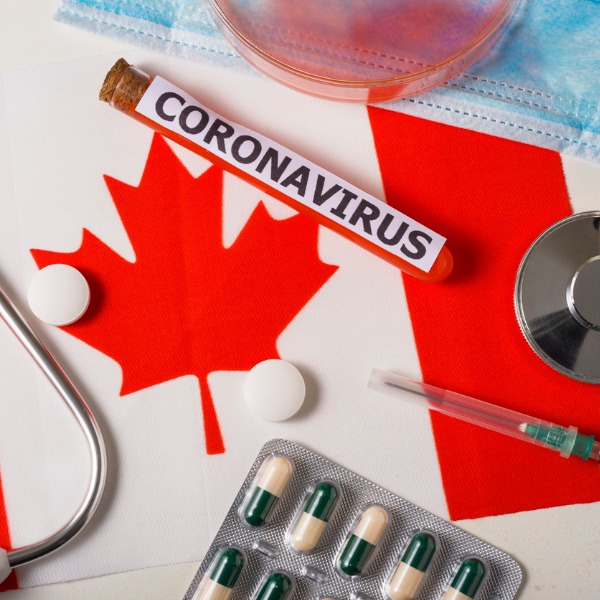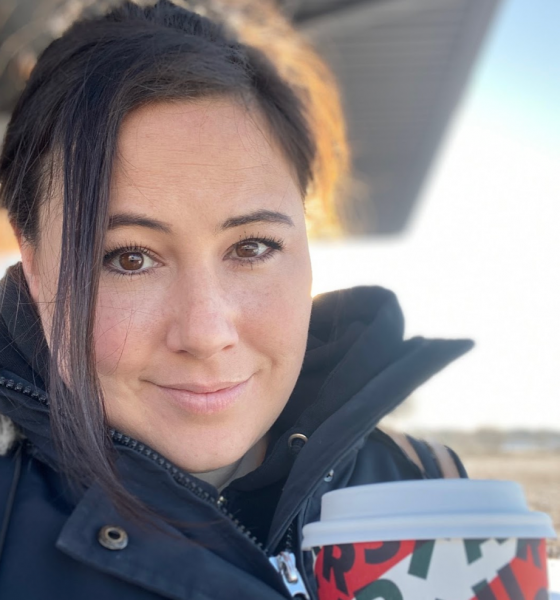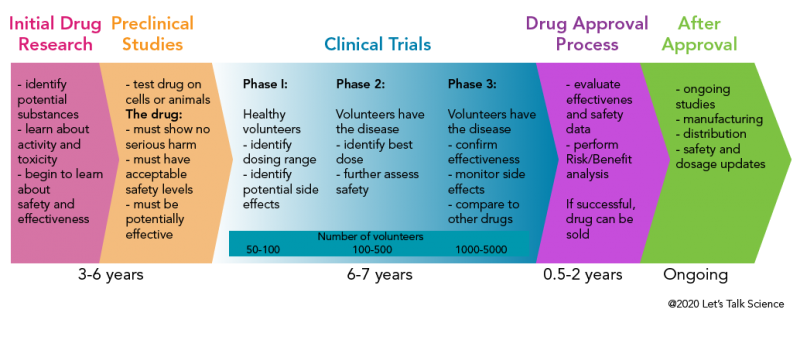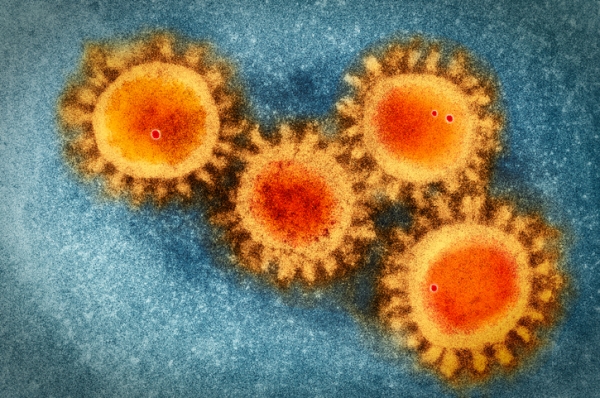Creating a Vaccine for COVID-19 in Canada

Medical supplies and Canada flag (beast01, iStockphoto)

Medical supplies and Canada flag (beast01, iStockphoto)
How does this align with my curriculum?
Learn how vaccines are developed, how they work and how some scientists in Canada are researching vaccines for COVID-19.
Did you ever think something microscopic would change our lives so much? In 2020, the COVID-19 virus did just that. We started our days reading about infection numbers. We started washing our hands more often. And we started social-distancing whenever we went out.
We talked about getting back to normal, or the new normal. We were also eager to hear about scientists working to develop a vaccine.
A vaccine encourages your body's immune system to fight a disease. It does this because it has a weakened form of the same virus that causes the disease. This helps your body create antibodies.
Vaccines have saved thousands of lives in Canada and around the world. For example, doctors in Canada started using the Polio vaccine in 1955. Now, the disease has almost vanished.
Did you know?
In August 2020, scientists were developing more than 95 different COVID-19 vaccines. Not all of them will work though. It can take a long time to make sure a vaccine is safe and effective. Scientists need to perform many tests on vaccines before they are used. These are called or clinical trials.
How Long Does It Take to Develop a Vaccine?
It usually takes at least 4 years to create a new vaccine. But scientists are trying to speed up this process for COVID-19. Laboratory and research testing will need to be faster. Then regulatory bodies will need to approve plans to test potential vaccines. Finally, if the vaccine is proven to be safe and effective, Health Canada would need to approve it.
There are global leaders in vaccine research working on COVID-19 vaccines in Canada. Two of them are based at the University of Manitoba. Dr. Lauren Kelly co-leads two clinical trials happening in Manitoba.

She leads a team of scientists at the Clinical Pharmacology Lab. They study drug safety.
Dr. Peter Pelka and his team study the structure of viruses. He uses DNA technology to build potential vaccines for COVID-19.

Dr. Pelka was asked how long it could take to develop a COVID-19 vaccine. He said:
“To test the efficacy and safety of a potential vaccine, one [that] is likely to be immunizing billions of people. The stakes are extremely high. [The] false sense of security caused by a failed vaccine would do much more harm than no vaccine at all. I think a much more realistic, but nevertheless a very rushed timeline, would be something on the order of 18 months to 2 years.
Our vaccine will be targeted to the Canadian population. As we are using the first Canadian isolate of SARS-CoV-2 to obtain the genes needed to make the vaccine. But that does not mean it will not be effective worldwide. The first study will involve testing of whether our vaccine induces the type of immunity a vaccine must elicit to be effective.”

It takes a lot of work to create a COVID-19 vaccine. And scientists around the world are helping. Even if one team is not successful, they will learn a lot through their research. This information will help many others.
Prevention Is Better Than Cure
What Makes a Vaccine So Useful?
When you're vaccinated, you’re exposed to an organism that causes a disease. But vaccines do not make you sick. They make your body create antibodies against the disease. You develop immunity. This means your body can stop infections before they even start!
Is a Vaccine Specific to a Disease?
Yes, it is. But sometimes scientists will try to reuse a vaccine. This will only work if one virus has a structure a lot like another virus. This is not true for coronavirus. It has a different shape than any other kind of virus.

What About Herd Immunity?
You need to be vaccinated to develop immunity in your own body. Or, you might become immune after getting sick and getting better. Herd immunity happens when most people in a population are immune.
But COVID-19 is dangerous. Scientists don’t know a lot about it yet. They do know that a small number of people who get sick will die from COVID-19. People who get sick may also have health problems for a very long time. The safest way for us to reach herd immunity is through vaccination.
If at least 60% of people become immune to COVID-19, there will be herd immunity. This means people who are immune will not be infected. And they won’t be able to spread the infection to anyone who is not immune. So, herd immunity can slow down the spread of a virus.
COVID-19 is a new virus. No one was immune to it when it started spreading around the world in January 2020. The virus spread quickly because it didn’t meet any opposition.
In December 2020, COVID-19 was still spreading. Over 62 million people around the world had been infected with the virus. This number includes over 370 000 people in Canada.
Did you know?
You can get up-to-date information about COVID-19 infections in Canada through the Government of Canada’s COVID-19 tracker.
These numbers are very large. But the world population is more than 7.8 billion people. So only a small percentage of our population may have immunity to COVID-19. And scientists still don’t know how long people might stay immune after they get sick. As of December 2020, scientists have not yet created a safe, effective vaccine. So, we are not yet close to reaching herd immunity.
Canada is in the Race for COVID-19 Treatments
Dr. Pelka believes “.... we can develop a vaccine that will work. And the more people try to do this using different approaches, the more likely it is that someone will succeed. However, HIV is an example of our failure to develop a vaccine in 40 years of trying. Nevertheless, this virus is a different beast. [It] replicates very differently to HIV and I think a vaccine is a real possibility.”
Dr. Kelly was asked about treatments for COVID-19. She said “Globally, there are several large consortiums evaluating different treatments for COVID-19. [They] have enrolled thousands of participants. We don’t have efficacy data from these studies just yet.”
She also raised new questions about children and COVID-19. “In children, we are seeing new presentations including a multi-system immune response. [This] really highlights the need to include children in COVID-19 research. There are many uncertainties especially about the long-term effects of the virus. I am not sure we will have a clear answer on that for years to come.”
Scientists in Canada have always worked to create new treatments and vaccines. This is also true for COVID-19. While we are waiting for data from research, we do see progress across Canada. Many universities are running clinical trials for a potential vaccine.
In the meantime, the best way to prevent COVID-19 is to follow the recommendations of Health Canada or your local health authority.
Starting Points
- Have you ever had a vaccine? What was it for?
- How has the COVID-19 pandemic impacted your life?
- Are you anxious for a vaccine to be developed for COVID-19? Why?
- Why is it important that any new vaccine be rigorously tested?
- How could a vaccine for COVID-19 impact the economy of Canada?
- What are some of the motivations for developing a vaccine for COVID-19 within Canada?
- Why has the COVID-19 virus spread so quickly around the world?
- What is herd immunity? When will herd immunity be achieved for COVID-19?
- How long does it typically take to develop a new vaccine? What is the shortest timeline that could be anticipated for a COVID-19 vaccine to be developed?
- What are the pros and cons of developing vaccines versus treatments for a disease like COVID-19?
- Why is the clinical trial process in place?
- Is the scientific community close to knowing all there is to know about COVID-19? What aspects of COVID-19 still require additional research?
- What is the value of long-term or ongoing research initiatives on diseases like COVID-19 and HIV?
- Find an article in the news about COVID-19. Does it mention anything about a vaccine or vaccine development for COVID-19? Does the article present a different perspective or timeline for vaccine development than this article presents? Explain.
- Where would you look for the most up-to-date and credible information about COVID-19 vaccine development progress in Canada?
- This article supports teaching and learning of Health and Biology related to the topic of viruses, vaccination, public health, immune system and clinical trials. Concepts introduced include immune system, vaccines, efficacy, clinical trial, and herd immunity.
- After reading this article, teachers could have students practice their critical thinking skills using a Pros & Cons Organizer learning strategy to consider the pros and cons of developing vaccines versus treatments for COVID-19. Ready-to-use Pros & Cons Organizer reproducibles for this article are available in [Google Doc] and [PDF] formats.
- Students could predict the long-term implications of COVID-19 on Canadian society using a Consequence Map Learning Strategy. Ready-to-use Consequence Map reproducibles for this article are available in [Google Doc] and [PDF] formats.
- To consolidate learning from this article, teachers could provide students with an Exit Slip. A ready-to-use Exit Slip for this article is available in [Google Doc] and [PDF] formats.
Connecting and Relating
- Have you ever had a vaccine? What was it for?
- How has the COVID-19 pandemic impacted your life?
- Are you anxious for a vaccine to be developed for COVID-19? Why?
Relating Science and Technology to Society and the Environment
- Why is it important that any new vaccine be rigorously tested?
- How could a vaccine for COVID-19 impact the economy of Canada?
- What are some of the motivations for developing a vaccine for COVID-19 within Canada?
Exploring Concepts
- Why has the COVID-19 virus spread so quickly around the world?
- What is herd immunity? When will herd immunity be achieved for COVID-19?
- How long does it typically take to develop a new vaccine? What is the shortest timeline that could be anticipated for a COVID-19 vaccine to be developed?
- What are the pros and cons of developing vaccines versus treatments for a disease like COVID-19?
Nature of Science/Nature of Technology
- Why is the clinical trial process in place?
- Is the scientific community close to knowing all there is to know about COVID-19? What aspects of COVID-19 still require additional research?
- What is the value of long-term or ongoing research initiatives on diseases like COVID-19 and HIV?
Media Literacy
- Find an article in the news about COVID-19. Does it mention anything about a vaccine or vaccine development for COVID-19? Does the article present a different perspective or timeline for vaccine development than this article presents? Explain.
- Where would you look for the most up-to-date and credible information about COVID-19 vaccine development progress in Canada?
Teaching Suggestions
- This article supports teaching and learning of Health and Biology related to the topic of viruses, vaccination, public health, immune system and clinical trials. Concepts introduced include immune system, vaccines, efficacy, clinical trial, and herd immunity.
- After reading this article, teachers could have students practice their critical thinking skills using a Pros & Cons Organizer learning strategy to consider the pros and cons of developing vaccines versus treatments for COVID-19. Ready-to-use Pros & Cons Organizer reproducibles for this article are available in [Google Doc] and [PDF] formats.
- Students could predict the long-term implications of COVID-19 on Canadian society using a Consequence Map Learning Strategy. Ready-to-use Consequence Map reproducibles for this article are available in [Google Doc] and [PDF] formats.
- To consolidate learning from this article, teachers could provide students with an Exit Slip. A ready-to-use Exit Slip for this article is available in [Google Doc] and [PDF] formats.
Learn more
How do vaccines work? (Oxford Vaccine Group) (2018)
This animation by the Oxford Vaccine Group (2:27 min.) describes how viruses, antibodies, and vaccines help us develop immunity.
How do vaccines work? (BC Centre for Disease Control) (2020)
This article from the BC Centre for Disease Control explains the basics of vaccines, and includes a video for parents about getting children vaccinated (1:21 min.).
Viruses (Updated) (2018)
This animated video (6:48 min.) from the Amoeba Sisters shows the structures of viruses and their life cycle.
A basic introduction to viruses from Khan Academy, explaining their structures and their life cycle.
Herd Immunity (Herd Protection) (2019)
Article explaining herd immunity, with video (2:46 min.), from the University of Oxford's Vaccine Knowledge Project.
References
Corum, J., Grady, D., Wee, S-L. and Zimmer, C. (Updated August 20, 2020). Coronavirus Vaccine Tracker. The New York Times. Manitoba.ca. (n. d.) Where can I get myself, or my child, immunized?
Johns Hopkins University & Medicine (n. d.) COVID-19 Dashboard by the Center for Systems Science and Engineering (CSSE) at Johns Hopkins University.
Mock, J. (2020, May 4). Is Herd Immunity Our Best Weapon Against COVID-19? Discover Magazine.
Ryan, H. (2020, May 16). Canada's first COVID-19 vaccine trials approved for Halifax university. CBC News.
Thomson Reuters. (2020 August 3). As COVID-19 survivors face months of complications, experts studying long-term costs. CBC News.
World Health Organization. (2020 August 4). Estimating mortality from COVID-19.